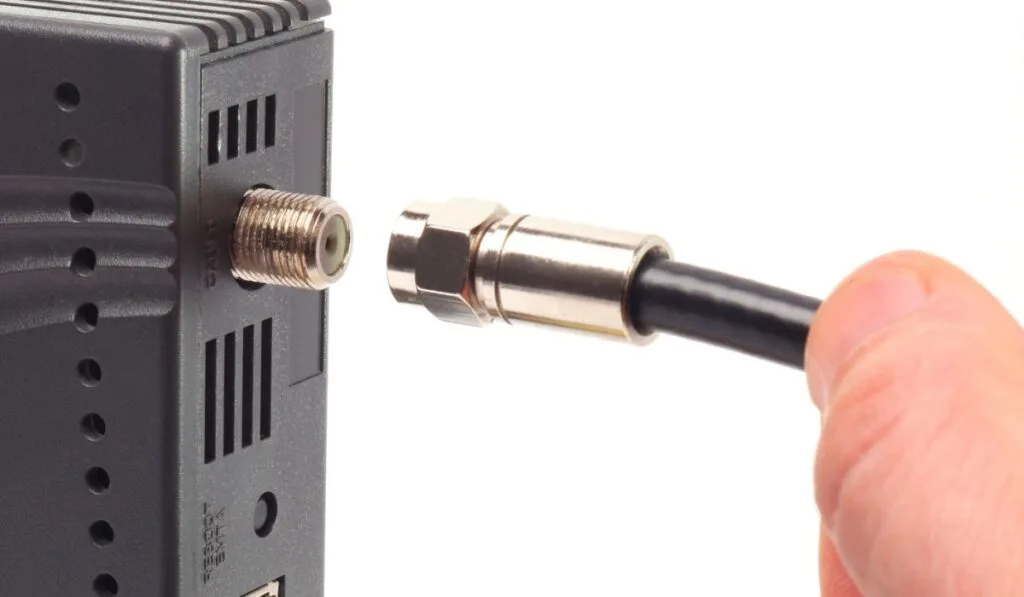If you’re reading this article, chances are you have a coaxial cable to thank. Coax cables are necessary for establishing an internet connection through a modem. But what are coax cables, and why do some routers use them?
Coaxial cables are a type of cable with round connectors and thicker shielding than ethernet. They’re less prone to interference, and since many homes already have Cable infrastructure, it’s often a cost-effective option to deliver internet to a modem through the a coax connection.
Let’s take a more detailed look at the differences between various types of Ethernet cables, the advantages coaxial cables have over Ethernet cables, and why some modems use coaxial cables in place of Ethernet cables.
What is a Coaxial Cable?

A “Coaxial” or simply “coax” cable like this one (example on Amazon) transmits data from one source to another and is the preferred way of connecting a router to a modem.
When setting up an internet connection within a building, a service provider may attach existing coaxial cables to modems, creating a wide area network or WAN. Sometimes service providers use existing phone lines for this, or even fiberoptic. Coaxial cable is just one type of “data pipe” the internet can be made to come in through.
Coax cables consist of two or more insulated wires wrapped around each other in what is known as a “spiral wrap.“ The outer layer of a coax cable is called the shield, which protects the inner wires from damage and interference.
The cables have been around for decades and are most commonly used for cable TV and internet connections. However, they can also connect computers, phones, security cameras, and other devices.
What is an Ethernet Cable?
An Ethernet cable connects multiple devices over a local area network (LAN). It consists of four twisted copper pairs shielded to reduce interference and noise.
Ethernet cables are known for their high speed and reliability. They offer faster speeds than wireless connections, making them ideal for streaming video, playing online games, and transferring large files.
Unlike coax cables, Ethernet connections require a particular type of connector called an RJ45. This connector is inserted into the end of the cable and plugs into a port on the device.
The jacket of an Ethernet cable is usually made of PVC or similar material to protect the wires. It also helps reduce interference from outside sources. However, compared to coax cables, the jacket of an Ethernet cable is more susceptible to damage.
What’s the Difference Between a Coaxial Cable and an Ethernet Cable?
While both cables connect devices over a network, their structures and connection methods vary.
But here’s the thing: Ethernet cables are a actually a category of cables that includes fiber-optic, twisted, and coaxial cables. The type of cable with four twisted copper pairs is simply what is most commonly referred to as an “Ethernet cable.”
Coaxial cables are thicker than Ethernet cables, so with a greater range of distance they can travel without signal loss. They are also more resistant to interference from other electrical sources and can transmit data faster than Ethernet cables.
Aside from the internet, coax cables are often used in television and cable due to their ability to transmit large amounts of data quickly and efficiently. And because that was the original, native purpose of coaxial cable: to deliver Cable TV to consumers. Using it for internet has been a comparatively recent innovation.
Ethernet cables are much thinner and have a shorter range than coax cables, but they are also more flexible. They require an RJ45 connector to connect to devices, while coax cables use a standard connector.
Ethernet cables also provide more consistent speeds and are better suited for connecting multiple devices simultaneously. However, the shielding on an Ethernet cable is also not as robust as a coax cable, making them more vulnerable to interference.
Why Does My Router Use a Coaxial Cable Instead of an Ethernet One?
Coaxes offers several advantages over Ethernet cables when it comes to networking. Sure, you can use Ethernet to connect your router to the internet, but the performance of a coaxial connection is superior in many ways.
Ethernet over Coax (EoC) is a popular way of connecting routers to the internet. Instead of using Ethernet cables, EoC uses coaxial cables to connect the router to a modem located in the same room or even in a different building.
EoC offers several advantages over standard Ethernet connections. The signals sent through EoC are much more resistant to interference and noise thanks to shielding and insulation, making them better suited for long-distance connections.
Additionally, the signals sent through coaxial cable do not degrade over long distances like those from an Ethernet connection. This means you can use a single coaxial cable to connect your router to a modem far away, whereas you would need multiple Ethernet cables to achieve the same result.
Finally, coaxial cables are generally much cheaper than Ethernet cables, so if you need to save money while setting up your network, a coaxial cable may be the way to go.
How to Connect a Coaxial Cable to a Modem/Router

Connecting a coaxial cable to your modem or modem/router combo is relatively simple. Here’s how to go about it:
- Plug one end of the coaxial cable into a wall outlet or cable box.
- Then connect the other end of the coaxial cable to the coax port on the modem.
- Once everything is connected, turn on your modem and router. You should be able to access the internet after the devices boot up and establish connections (5-15m).
